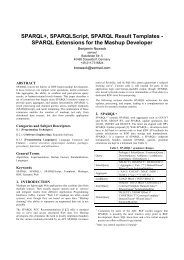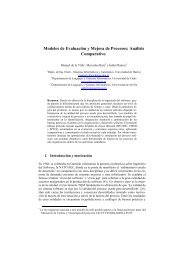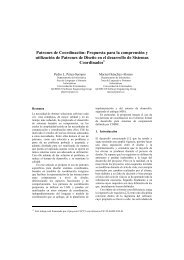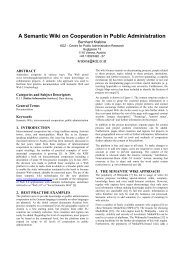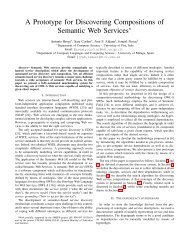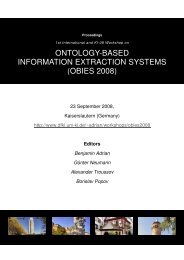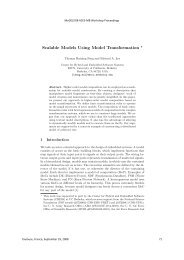Sim-Filter: User Profile based Smart Information Filtering and - FTP
Sim-Filter: User Profile based Smart Information Filtering and - FTP
Sim-Filter: User Profile based Smart Information Filtering and - FTP
Create successful ePaper yourself
Turn your PDF publications into a flip-book with our unique Google optimized e-Paper software.
SIM-<strong>Filter</strong>: <strong>User</strong> <strong>Profile</strong> <strong>based</strong> <strong>Smart</strong> <strong>Information</strong><br />
<strong>Filter</strong>ing <strong>and</strong> Personalization in <strong>Smart</strong>card<br />
Abdelkrim Lahlou 1 , Pascal Urien 1,2<br />
1 Schlumberger Systèmes, <strong>Smart</strong>card Research Center, 36-38, Rue de la princesse, BP 45,<br />
78431 Louveciennes Cedex, France<br />
Abdelkrim.Lahlou@louveciennes.sema.slb.com<br />
2 Ecole Nationale Supérieure des Télécommunications - ENST Paris, 46, Rue Barrault<br />
75634 Paris Cedex 13, France<br />
Pascal.Urien@enst.fr<br />
Abstract. The emergence of new information <strong>and</strong> communication system<br />
technologies allow the appearance of new techniques of data processing. Thus,<br />
it is increasingly difficult to user to find pertinent information in reasonable<br />
duration, unless knowing what exactly is looking-for, where <strong>and</strong> how getting it.<br />
We propose an Internet <strong>based</strong> filtering system that integrates user profile (i.e.<br />
identity <strong>and</strong> preferences data). <strong>User</strong> profile is embarked in a smartcard in order<br />
to guarantee its privacy <strong>and</strong> confidentiality. Our system objectives are twofold.<br />
First, we propose an evolved <strong>and</strong> extensible model to represent the user<br />
preferences with guaranty of privacy <strong>and</strong> security. The more the user surfs on<br />
the web, the more his profile is enriched implicitly. Second, our system must<br />
provide the pertinent information to the user according to his profile at any<br />
time, anywhere, <strong>and</strong> in any form. The design <strong>and</strong> implementation of our system<br />
is also presented.<br />
1 Introduction<br />
The advancement of networking <strong>and</strong> Internet technology has recently driven the rapid<br />
development <strong>and</strong> spread of World Wide Web. The emergence of new information <strong>and</strong><br />
communication system technologies allow the appearance of new techniques of data<br />
processing. The services providers deploy new accessible personalized services<br />
through the Web that becomes vector of fast <strong>and</strong> effective communication. Not only,<br />
many information sources become available, but the exponentially information<br />
expansion also raises another subtle problem. Thus, finding relevant information<br />
effectively on the Internet is a challenging task. The informational potential made<br />
available to every one is becoming so considerable that it is increasingly difficult to<br />
user to find pertinent information in reasonable duration, unless knowing what exactly<br />
is looking-for, where <strong>and</strong> how getting it. Therefore, although searching tools ease the<br />
finding of information, the main problem to explore Web sites remains. What the user<br />
really need is a software agent that provides him the available <strong>and</strong> pertinent<br />
information at any time, anywhere, <strong>and</strong> in any form. Realizing such a promise<br />
depends on innovations in areas that impact the creation of information services <strong>and</strong><br />
their communication infrastructures. Therefore, in this paper, we present an Internet
ased filtering system that uses user’s profile (user’s identity <strong>and</strong> preferences data).<br />
This system provides to users pertinent information <strong>and</strong> guarantees user privacy <strong>and</strong><br />
confidentiality. <strong>User</strong> profile is embarked in a smartcard, which provides mobility <strong>and</strong><br />
high security.<br />
<strong>User</strong> profile can be used in many contexts among which information<br />
personalization <strong>and</strong> mobile computing. This information contained in the user profile<br />
is very confidential. For this reason, securing user profile is crucial. These points are<br />
presented in what follows.<br />
(1) <strong>User</strong> profile <strong>and</strong> information personalization: The complexity of information<br />
research criteria constitutes the principal difficulty for the users when they formulate<br />
their requests, in particular when they specify the same criteria in a recurring way in<br />
various requests. The modeling of these criteria in the form of profiles allows<br />
mitigating these problems. It is possible for the user to partially specify his requests,<br />
which will be automatically supplemented <strong>and</strong> enriched by his profile before their<br />
execution. The user’s profile can be defined like a modeling of his centers of interests<br />
(spheres of activity, level of data quality, level of security, etc). It can be described by<br />
a schema (metadata) <strong>and</strong> whole of request-types. The profile modeling provides to the<br />
user a simple way to express his requests. These requests can be rewritten <strong>and</strong><br />
enriched by user profile before their execution. The rewriting mechanism is close to<br />
the rewriting of request through the databases views that is treated in an abundant way<br />
in databases literature [1], but with a higher degree of complexity. The information<br />
filtering <strong>and</strong> personalization in the context of information retrieval of text, audio or<br />
video type, such in the search engines or digital libraries, is out of the scope of this<br />
paper. Nevertheless, we will be inspired of the later works, in particular how to model<br />
user’s profile.<br />
(2) <strong>User</strong> profile <strong>and</strong> mobile computing: In the context of mobile computing, the<br />
user mobility entails various problems bound to the limits of the current storage <strong>and</strong><br />
communication infrastructures. On one h<strong>and</strong>, the user is equipped with a mobile<br />
terminal presenting some limits such as: processing capability, storage capacities,<br />
energy autonomy, weight <strong>and</strong> dimensions, working interface ergonomics, etc. On the<br />
other h<strong>and</strong>, he is constrained by limited characteristics of the communication support<br />
such as: reduced b<strong>and</strong>width, raised disconnection ratio, various radio signal<br />
disturbances, variations in performances <strong>and</strong> reliability, data security vulnerability,<br />
etc. The mobile user wishes to find a navigation interface similar to that he has at<br />
home, in work or elsewhere during his mobility [2]. He hopes that his work<br />
environment will be reconfigured automatically at each connection. The user wishes<br />
also to maintain <strong>and</strong> synchronize his mobile terminal information with fixed data<br />
sources to which he accesses. He would get accurate information at time of his<br />
research <strong>and</strong> taking into account his preferences <strong>and</strong> his actual or future situation.<br />
These constraints make even more complex the task of managing the nomad user<br />
mobility. In this context, the personalization of the user interface according to his<br />
profile <strong>and</strong> constraints of the mobile environment (mobile terminal <strong>and</strong> radio<br />
interface) will be very helpful. It is also essential to guarantee the security <strong>and</strong> the<br />
confidentiality of his data <strong>and</strong> requests with his displacements. In our context, <strong>and</strong><br />
since the user profile is embarked in the smartcard, the user can find easily his<br />
execution environment.
(3) Securing user profile: The representation of the entire user personal<br />
information, such as his services <strong>and</strong> presentation preferences, makes them very<br />
vulnerable. This personal data requires a high security level so that the user relies on<br />
his service/information providers. The confidentiality <strong>and</strong> the integrity of this<br />
information must be guaranteed. Therefore, a mutual confidence between the user <strong>and</strong><br />
his providers must be established. The loading of these data in smartcard constitutes a<br />
high security level while making them mobile. As we present after, a judicious choice<br />
on representation of the profiles in smartcard is necessary, considering its limited<br />
characteristics about computing power <strong>and</strong> storage capacity.<br />
Our application scenario is shown in Fig. 1. It represents our Internet <strong>based</strong><br />
filtering system “SIM-<strong>Filter</strong>”. Our system objectives are twofold. First, we propose an<br />
evolved <strong>and</strong> extensible model to represent <strong>and</strong> exploit user profile with guaranty of<br />
privacy <strong>and</strong> security. Second, our system must provide the available <strong>and</strong> pertinent<br />
information to the user according to his preferences at any time, anywhere, <strong>and</strong> in any<br />
form. The user profile contributes to offer a personalized information search <strong>and</strong><br />
adaptable diffusion services to the users. It also helps to propose to users the most<br />
appropriate information, in suitable form <strong>and</strong> minimal effort. The user introduces his<br />
personal profile (identity <strong>and</strong> preferences data) in an explicit manner via a Java<br />
Interface. He can access to his profile anytime to reach <strong>and</strong> update its content. The<br />
profile is enriched also in an implicit manner according to the user's requests <strong>and</strong><br />
selected responses. The goal of the implicit maintenance of the profile is to make it<br />
evolutionary <strong>and</strong> extensible. Our system integrates the user’s profile in his requests<br />
before they will be processed. The more the user surfs on the web, the more his<br />
profile represents him <strong>and</strong> then the more his results are relevant. We design <strong>and</strong><br />
implement our system on adapted HotJava 1 browser <strong>and</strong> we embark the user profile<br />
on Java smartcard.<br />
Request<br />
<strong>Information</strong><br />
source<br />
Interrogation<br />
<strong>User</strong><br />
Request update<br />
<strong>Profile</strong> update<br />
Fig. 1. SIM-<strong>Filter</strong> components<br />
Publication<br />
<strong>Profile</strong><br />
<strong>Smart</strong>card<br />
The rest of this paper is organized as follows: Section 2 reviews some related<br />
works on information filtering <strong>and</strong> user profile modeling. In Section 3, we present<br />
how to embark user profile in smartcard. We describe smartcard technology issues,<br />
1 http://java.sun.com/products/hotjava/
<strong>and</strong> user profile building <strong>and</strong> implementation in smartcard. We describe our Internet<br />
<strong>based</strong> filtering system architecture <strong>and</strong> present an execution scenario in Section 4. We<br />
conclude <strong>and</strong> present our future work in Section 6.<br />
2 Related Works<br />
A filtering is crucial task in information delivering to users. <strong>User</strong>’s needs are modeled<br />
by his profile. Many works have been done on information filtering <strong>and</strong> many<br />
techniques have been proposed. This section presents some related works on<br />
information filtering <strong>and</strong> user profile modeling.<br />
2.1 <strong>Information</strong> <strong>Filter</strong>ing<br />
Belkin <strong>and</strong> Croft mention in [3] that information filtering describes a variety of<br />
processes involving the delivery of information to people who need it. Although, this<br />
term is appearing quite often in popular <strong>and</strong> technical articles describing applications<br />
such as electronic mail, multimedia distributed systems, news services systems <strong>and</strong><br />
digital libraries. <strong>Filter</strong>ing applications typically involve streams of incoming data,<br />
either being broadcast by remote sources such as news servers, or sent directly by<br />
other sources such as E-mail. <strong>Filter</strong>ing concerns also the process of accessing <strong>and</strong><br />
retrieving information from remote databases, in which case the incoming data is the<br />
result of the database requests.<br />
<strong>Information</strong> filtering systems are <strong>based</strong> on description of individual or group<br />
information preferences, often called profiles. Such profiles typically represent longterm<br />
interests of the user or community of users. The filtering process is often meant<br />
to imply the removal of data from an incoming stream, rather than finding data in<br />
that stream. In the first case, the users see what is left after the data is removed; in the<br />
latter case, they see what is extracted after the data is found. A common example of<br />
the first approach is an electronic mail filter designed to remove “junk” mails.<br />
Whereas, in the second approach, an example is to find only mail coming from a<br />
particular “diffusion list”. This means that profiles may not only express what users<br />
want, but also what they do not want.<br />
There are different filtering techniques referred in several research papers such as<br />
Boolean filtering [4], vector space techniques [5],[6],[7],[8],[4], probabilistic filtering<br />
[7],[9], linguistic <strong>and</strong> learning filtering techniques (neural networks, Case-Based<br />
Reasoning, genetic algorithms, etc.) [1],[11],[12],[13],[14], <strong>and</strong> [15].<br />
2.2 <strong>User</strong> <strong>Profile</strong> Modeling<br />
The Platform for Privacy Preferences Project (P3P), developed by the World Wide<br />
Web Consortium (W3C), determines a global architecture to preserve confidentiality<br />
on the Web [16]. This architecture offers secured profile exchange between a<br />
customer <strong>and</strong> a server. The goal of P3P is twofold. First, it allows Web sites to present<br />
their data-collection practices in a st<strong>and</strong>ardized, machine-readable, easy-to-locate
manner. Second, it enables Web users to underst<strong>and</strong> what data will be collected by the<br />
sites they visit <strong>and</strong> how data will be exchanged <strong>and</strong> used. The Web site accesses using<br />
a script, in reading state, to user’s private preferences with respect of specific<br />
confidentiality constraints. On the other h<strong>and</strong>, all access attempting, in writing state,<br />
to profile is rejected. The P3P profile advantage is to (i) represent the user’s<br />
preferences data, (ii) share these personal data with Web sites <strong>and</strong> (iii) guarantee their<br />
privacy <strong>and</strong> confidentiality. However, the P3P profile contains only static information<br />
<strong>and</strong> limited to the user's identification without taking in consideration his preferences.<br />
In P3P, the user can introduce or modify directly his profile data via an interface. The<br />
profile modeling is simple because the user's personal data does not frequently<br />
evolve. It does not take in account the dynamic aspect of the profile (i.e. preferences).<br />
A concrete example of using user profile is presented in [2]. The authors present<br />
<strong>and</strong> implement a general user profile model in the context of digital libraries. The<br />
system is a personalized gathering <strong>and</strong> delivering for heterogeneous information<br />
sources <strong>based</strong> on user profiling model.<br />
It is clear that except the P3P project, the majority of the systems <strong>and</strong> existing tools<br />
of filtering disregard the security aspect of the user profile. However, P3P limits itself<br />
to the user's identification without taking in consideration his preferences. It does not<br />
also permit to take in account the dynamic aspect of the profile; it is limited to a static<br />
profile.<br />
We extend the P3P model to represent user profile by including its dynamic aspect<br />
(i.e. user’s preferences). The user introduces his preferences in an explicit manner.<br />
The profile is enriched dynamically in an implicit manner. Fig. 2. shows user profile<br />
components. Our Internet <strong>based</strong> filtering system exploits user profile to remove<br />
irrelevant information <strong>and</strong> to find pertinent one.<br />
<strong>Profile</strong><br />
3 <strong>User</strong> <strong>Profile</strong> on <strong>Smart</strong>card<br />
Identity<br />
Preferences<br />
St<strong>and</strong>ardized by W3C (P3P)<br />
Dynamic aspect (proposal)<br />
Fig. 2. <strong>User</strong> profile components<br />
<strong>Smart</strong>cards are the most secure portable computing device today. They have been<br />
used successfully in applications involving money, proprietary <strong>and</strong> personal data<br />
(such as banking, healthcare, insurance, etc.). The integration of the smartcard in<br />
information filtering process guarantees higher security but it presents two main<br />
constraints: (1) performances in terms of computing capacity <strong>and</strong> (2) storage
capabilities. In this section, we present first the smartcard technology <strong>and</strong> then the<br />
implementation of user profile in Java smartcard.<br />
3.1 <strong>Smart</strong>card Technology<br />
A smartcard as represented in Fig. 3. contains most of classic computer components,<br />
i.e. a CPU, a ROM (storing operating system code), a RAM (dedicated to stack<br />
operations), a persistent EEPROM memory (storing java byte code or user data), a<br />
communication bus, <strong>and</strong> a way to communicate with the outside world via an<br />
Input/Output connector. Silicon technology has considerably reduced the transistor<br />
size for smartcards to reach 0.18-micron process thus enabling important integration<br />
progress. The CPU of current smartcards is a 32-bit microprocessor with a processing<br />
power of 33 MIPS (Million Instructions Per Second) at a frequency of 33MHz.<br />
32<br />
bits<br />
Proc.<br />
I/O Connector Security Bloc<br />
Bus<br />
ROM 256KB RAM 4 KB EEPROM 64 KB<br />
Fig. 3. <strong>Smart</strong>card global architecture<br />
The smartcard components need 50µs to process a cryptographic DES algorithm<br />
<strong>and</strong> only 200ms are necessary to compute a 1,024-bit RSA signature. As mentioned in<br />
[17] crypto-coprocessors could be replaced by dedicated cryptographic instruction in<br />
CPU cores. Memory capacities range from 128 to 256Ko of ROM, from 64 to 128Ko<br />
of EEPROM <strong>and</strong> from 4 to 8Ko of RAM. Writing data in EEPROM is relatively slow.<br />
It takes 1ms to write a 32 or a 64-bits word <strong>and</strong> it can be done only one million of<br />
times. The performance of smartcard’s components will be a key issue in a closed<br />
future, as it could allow smartcards to be considered as the most secure<br />
communicating object on the Internet. <strong>Smart</strong>card’s capabilities are drastically limited<br />
due to its size. Fortunately, this will evolve rapidly. <strong>Smart</strong>cards with memories of few<br />
megabytes have been announced for 2003. Access to those memories is also a<br />
problem that will no longer exist with new memories such as FeRAM (10 9 writing<br />
operations allowed, memory capacity around one megabyte <strong>and</strong> writing delay less<br />
than 200ns). Processors frequency will probably progress according to the Moore law.<br />
One of the major chip manufacturers foresaw that the CPU would only occupy 10%<br />
of the area on the next generation of chip leaving more space for bigger Non Volatile<br />
Memory. Finally, one could expect secure dies with computing performances around<br />
200 MIPS <strong>and</strong> memory capacities about 1 Mb, at the horizon of 2005's.
3.2 <strong>User</strong> <strong>Profile</strong> Building<br />
<strong>User</strong> profile is built using information personalization techniques. We distingue two<br />
kinds of personalization: the explicit <strong>and</strong> implicit personalization. Explicit<br />
personalization consists in interrogating user directly on his needs, whereas, in<br />
implicit personalization, the profile is built by examining (in real time or not) user<br />
operations on the Web. The explicit/implicit personalization is also called<br />
personalization or filtering by rules. Our system is <strong>based</strong> on information<br />
personalization. In the both case of personalization, there is an automatically<br />
collection of information regarding user behavior. This information must be analyzed<br />
<strong>and</strong> classified according to the type of data viewed (consulted documents, clicks,<br />
bought products either wanted, Web search, etc.), then stored in a database. This<br />
perpetual enrichment permits to have a unified view of user behavior at anytime.<br />
Details about these two kinds of personalization are described in what follows:<br />
(1) Explicit <strong>Filter</strong>ing: In the explicit personalization (namely explicit filtering), the<br />
profile content is built according to the information given voluntarily by the user at<br />
the time of his subscription. The user describes himself, in explicit manner, his<br />
personal information <strong>and</strong> his centers of interests, via a form for example. It is called<br />
declarative or static modeling of user preferences. The explicit filtering presents the<br />
drawback to require the user's active involvement to describe his preferences. Besides,<br />
the user hesitates to introduce truthful personal information.<br />
(2) Implicit <strong>Filter</strong>ing: In the implicit personalization (namely implicit filtering), the<br />
profile content is built according to user’s habits of navigation <strong>and</strong> while analyzing<br />
his clicks. The purchase forms, electronic subscriptions, dem<strong>and</strong>s of documentation<br />
are, as many others opportunities, a source to collect some information on user. The<br />
implicit personalization provides dynamic (evolutionary <strong>and</strong> extensible) modeling of<br />
user preferences. The implicit personalization presents the advantage that it does not<br />
require an active involvement of the user.<br />
The combination of the explicit <strong>and</strong> implicit personalization techniques proves to<br />
be more efficient while integrating training techniques or the intelligent agents. These<br />
techniques put up to date or revalue the user profile according to his actions.<br />
3.3 <strong>User</strong> <strong>Profile</strong> Implementation<br />
<strong>User</strong> profile is well presented in a database. However, smartcards have severe<br />
hardware limitations (very slow write, very little RAM, constrained stable memory,<br />
no autonomy, etc.), which make traditional database technology irrelevant. The major<br />
problem is scaling down database techniques so they perform well under these<br />
limitations. In paper [18], authors give a depth analysis of this problem <strong>and</strong> propose a<br />
PicoDBMS solution <strong>based</strong> on highly compact data structures, query execution<br />
without RAM <strong>and</strong> specific techniques for atomicity <strong>and</strong> durability. We use this<br />
solution to implement user profile in the smartcard.<br />
The user enters a new profile or edit/delete an old one via a java Interface (see Fig.<br />
4.). This profile is stored on the pico-Database. The application uses a JDBCDriver<br />
<strong>and</strong> SQL statement similar to one used in a classical Database. It is completely<br />
transparent to the application to access the pico-Database with the JDBCDriver. We
ecall, that user profile is composed of user identity <strong>and</strong> preferences. Preferences are<br />
first stored in explicit manner, <strong>and</strong> then enriched implicitly. Our system observes the<br />
user's actions <strong>and</strong> deducts some of implicit data that represent his opinions on the<br />
proposed information.<br />
<strong>Smart</strong>card<br />
PicoDBMS<br />
JDBCDriver<br />
SQL<br />
Fig. 5. <strong>User</strong> profile implementation<br />
Java Interface<br />
For example, suppose that user likes classical music. He setup his preference<br />
according to this choice. For this, our application maintains a list of MIME file type<br />
that specifies the type of each file in the Internet. When user clicks on music file on<br />
the web, we can detect the kind of this music (technique known as “click-stream<br />
tracking”). By analyzing the behaviors of the user, <strong>based</strong> on the number of time that a<br />
given link has been selected of a list of results, the number of time that a document<br />
has been consulted, the time passed on a document or a site, etc., we detect that the<br />
user often listen to rock music. Therefore, our system adapts user preference <strong>and</strong><br />
update/add rock music to user preferences.<br />
4 Internet Based <strong>Filter</strong>ing System<br />
There are two techniques of information filtering. Fig. 6. explains these techniques. In<br />
the first case, the user formulates his request (Request Q1), which is combined with<br />
his profile before queering the web. In the second case, the result of the request<br />
(Request Q2) is combined with the profile to get only pertinent response. The<br />
advantage of the first technique is the optimization of the resources used such as<br />
b<strong>and</strong>width consumption <strong>and</strong> execution time. It presents some drawback related to the<br />
security <strong>and</strong> confidentiality of the profile. It is clear, that in this case everyone can<br />
discover user profile, which may contain personal <strong>and</strong> private information about the<br />
user. It is necessary then to secure the storage of the profile (this is already provided<br />
by the smartcard) but also its transfers (network communication). The second<br />
technique deals with the security problem, since the profile is combined locally with<br />
the request only after getting responses. The drawback of this technique is the<br />
resources consumption.
DB BDP <strong>Profile</strong><br />
Request Q1(Expression)<br />
2<br />
Request Q2’ [Post <strong>Filter</strong>ed]<br />
4.1 System Architecture<br />
1<br />
Request Q1’ [Pre <strong>Filter</strong>ed]<br />
Web<br />
1: Pre-filtered result<br />
2: Post-filtered result<br />
Fig. 6. Two Scenarios of Internet <strong>Filter</strong>ing<br />
Request Q2 (Expression)<br />
Our implementation consists of Java module, which extends the functionalities of<br />
HotJava browser. HotJava TM browser provides a highly customizable modular solution<br />
for creating <strong>and</strong> deploying Web-enabled applications across a wide array of<br />
environments <strong>and</strong> devices [19]. Our module communicates with the smartcard using<br />
JDBCDriver. The smartcard plays the role of proxy since it can allow or not the<br />
browser to make connection in the Internet [20]. The architecture of our Internet<br />
<strong>based</strong> filtering system “SIM-<strong>Filter</strong>” is shown in Fig. 7. In reality, there are two<br />
execution modes. In the first mode, the smartcard authenticates the user’s URL. For<br />
example it checks if the tapped URL is not forbidden. If the URL is acceptable then it<br />
allows the browser to connect directly to the Internet, else it sends a message error<br />
indicating that the URL is not authorized. In the second mode, the smartcard is<br />
viewed as proxy, in which the browser connects indirectly to the Internet (via the<br />
smartcard proxy). The last mode is not implemented in our system because of the<br />
limited capabilities of today’s smartcard. All traffic going to the browser must be<br />
filtered in the smartcard, <strong>and</strong> this requires a high degree of computation.<br />
Connection<br />
Request<br />
HotJava<br />
Browser<br />
<strong>Smart</strong>card<br />
Connection<br />
Response<br />
Data Stream<br />
Internet<br />
Fig. 7. Internet <strong>based</strong> filtering system architecture<br />
1
4.2 Execution Scenario<br />
Let us take the example of user who wants to find some flight (see Fig. 8.). The user<br />
specifies in his profile that he is only interested by flight with price lower than $300.<br />
When the user makes his request, the profile is combined with his query as shown in<br />
Fig. 6. This example presents only pre-filtering mode, which is actually implemented<br />
in our system. Post-filtered mode is more complex <strong>and</strong> requires high computation<br />
capabilities from the smartcard.<br />
Conclusion<br />
Request<br />
Select * From Flight<br />
Where Destination = ‘New York’<br />
And Departure = ‘Paris’<br />
And Date = ‘1/11/02’<br />
And Class = ‘Hospitality’<br />
user<br />
<strong>Smart</strong>card<br />
Select * From Flight<br />
Where Destination = ‘New York’<br />
And Departure = ‘Paris’<br />
And Date = ‘1/11/02’<br />
And Class = ‘Hospitality’<br />
And Price < 300<br />
Order by Price<br />
Fig. 8. Example of flight request<br />
Price < 300$<br />
Finding effectively relevant information on the Internet is becoming a challenging<br />
task. In this paper, we presented a secure <strong>and</strong> extensible model to represent user<br />
profile. We extended the P3P model of identity representation by integrating user<br />
preferences. These preferences are introduced in an explicit manner <strong>and</strong> increase<br />
dynamically implicitly. Furthermore, embarking user profile in smartcard makes it<br />
more robust <strong>and</strong> high secure. We developed an Internet <strong>based</strong> filtering system SIM-<br />
<strong>Filter</strong>, which benefits from user profile to filter information. <strong>User</strong> profile can be<br />
combined before the request <strong>and</strong> is called pre-filtering model, or after the request <strong>and</strong><br />
is called post-filtering model. The post-filtering model requires high computation<br />
capabilities, which are left on today’s smartcards.<br />
Actually, we are planning to provide an extended secured personalized filtering<br />
service <strong>based</strong> on our architecture on the context of Pay for view TV. <strong>User</strong> defines<br />
allowed TV channels <strong>and</strong> emissions. According to this information, our system can<br />
authorize movie view or not.<br />
profile
References<br />
1. Halevy A.Y. : Answering Queries Using Views : A Survey. In VLDB journal, (2001)<br />
(http://www.cs.washington.edu/homes/alon/site/files/view-survey.ps)<br />
2. Cherniack M., Franklin M.J., Zdonik S. : Expressing <strong>User</strong> <strong>Profile</strong>s for Data Recharging. In<br />
IEEE Personal Communications, (2001)<br />
3. Belkin N.J., Croft W.B. : <strong>Information</strong> filtering <strong>and</strong> information retrieval : two sides of the<br />
same coin. In Communications of the ACM. Vol. 35(12), (1992) 29-38<br />
4. Yan T.W., Garcia-Molina H. : The SIFT <strong>Information</strong> Dissemination System. In ACM<br />
Transactions on Database Systems, (2000)<br />
5. Deerwester S., Dumais S.T., Furnas G., Laundauer T., Harshman R. : Indexing by Latent<br />
Semantic Analysis. In Journal of the American Society for <strong>Information</strong> Science, (41),<br />
(1990) 391-407<br />
6. Foltz P.W., Dumais S.T. : Personalized <strong>Information</strong> Delivery: An Analysis of <strong>Information</strong><br />
<strong>Filter</strong>ing Methods. In Comminucations of the ACM, 35(12), (1992) 51-60 (http://wwwpsych.nmsu.edu/~pfoltz/cacm/cacm.html)<br />
7. Larson R.R. : Evaluation of retrieval techniques in an experimental online catalogs. Journal<br />
of the American Society for <strong>Information</strong> Science 43(1), (1992) 34-53<br />
8. Salton G., McGill M.J. : Introduction to modern <strong>Information</strong> Retrieval. McGraw-Hill<br />
Edition, New York, (1983)<br />
9. Van Rijsbergen C.J. : <strong>Information</strong> Retrieval. Butterworths 2nd Edition, London, (1979)<br />
10. Aamodt A., Plaza E. : Case-Based Reasoning: Foundational Issues, Methodological<br />
Variations <strong>and</strong> System Approaches. AI Communications, Vol.7, (1994) 39-59<br />
11. Boughanem M. : Les systèmes de recherche d’informations : d’un modèle classique à un<br />
modèle connexionniste. Phd Thesis, Computer Science. Paul Sabatier University, Toulouse,<br />
France, (1992)<br />
12. Goldberg D. : Genetic Algorithms in Search, Optimisation, <strong>and</strong> Machine Learning.<br />
Addison-Wesley,Wokingham, Engl<strong>and</strong>, (1989)<br />
13. Haykin S. : Neural Networks - A Comprehensive Foundation. Prentice Hall International,<br />
(1994)<br />
14. Kobsa A. : <strong>User</strong> Modeling in Dialog Systems: Potentials <strong>and</strong> Hazards. AI & Society: The<br />
Journal of Human <strong>and</strong> Machine Intelligence, 4(3), (1990) 214-240<br />
15. Shardan<strong>and</strong> U., Maes P. : Social <strong>Information</strong> Filtring : Algorithms for Automating Word of<br />
Mouth. Proceedings of the CHI’95 Conference, (1995)<br />
16. P3P : Platform for Privacy Preferences Project home page. (http://www.w3.org/P3P)<br />
17. Urien P., Tizraoui A., Loutrel M. : SIM-IP card benefits for a profitable business model in<br />
emerging VoIP technologies. In Proceeding e<strong>Smart</strong>’02, (2002)<br />
18. Pucheral P., Bouganim L., Valduriez P., Bobineau C. : PicoDBMS: Scaling down Database<br />
Techniques for the <strong>Smart</strong>card. In VLDB Journal, 10(2-3), (2001)<br />
19. Sun Microsystems: HotJava Browser Home page. (http://java.sun.com/products/hotjava)<br />
20. Urien, P. : Internet Card, a smart card as a true Internet node. Computer Communication,<br />
Vol. 23 Issue 17, (2000)



